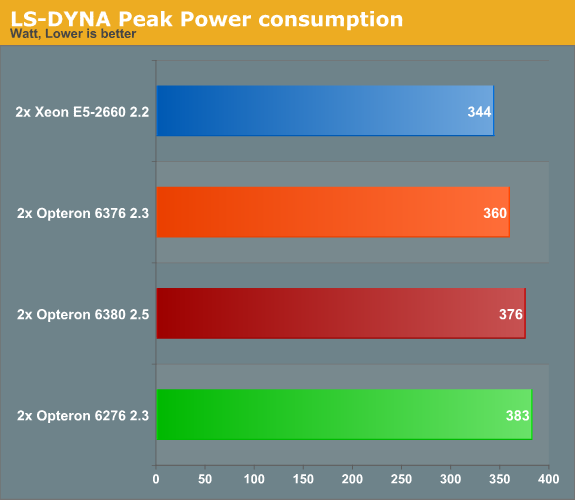The new Opteron 6300: Finally Tested!
by Johan De Gelas on February 20, 2013 12:03 AM ESTLS-DYNA Power Consumption
For HPC buyers, peak power tends to be a very important metric. As HPC systems are run at close to or equal to 100% CPU load, the energy consumption is at its peak for a long time. Peak power thus also determines the cooling and energy requirements. This is in sharp contrast with most other servers, where calculating the power and amps based on the peak load of a complete rack is considered wasteful as it is highly unlikely that all servers will hit 100% CPU load at the same time. We took the 95th percentile of our power numbers.

Note that the Xeon E5 numbers are not directly comparable to the Opteron numbers as the CPUs are tested in servers with different form factors. We will tackle that in the next test. Let us focus on the Opteron results for now.
AMD has made some real progres here. At the same clock, the total power consumption is 6% lower. Even at a 200MHz higher clock the peak power is very slightly—but consistently—lower (2%).
Of course, we also want to compare the AMD and Intel CPUs directly. To do this, we always run the fans at maximum speed. That way, the fans always consume the same amount of power. We then test with one and two CPUs, while keeping the amount of memory (64GB) the same. This way we measure how much extra power you consume at the wall when you add a second CPU. This number thus includes the voltage regulators (which can amount to up to 10% of the total server power) and the PSU inefficiency.

The Intel Xeon has a TDP of 95W, but even with a very FP intensive application it does not get anywhere near that number. About 75W out of those 94W are consumed by the CPU, as measured by our Hardware Monitoring Software that reads out the MSRs. We are still working on our version for the AMD platform (AMD's documentation is a bit late), but we estimate that the Opteron 6376 consumes about 110W and the Opteron 6380 needs about 120W. That means that AMD's top CPUs are probably consuming a bit more than their TDP indicates if you push the FP unit hard.
We also tried to measure idle power. Take the numbers with a grain of salt, but we measured about 19-20W for the Opteron 6380 (p-states disabled), 17-18W for the Opteron 6376 and 16-17W for the Xeon.










55 Comments
View All Comments
arnd - Wednesday, February 20, 2013 - link
I have dual Opteron 6344 workstation system, which tends to be either near complete idle or near complete busy, so C states are extremely important to me. The CPU has power sensors that are exposed in Linux using the 'sensors' tool. With C6 enabled, I get the power consumption per socket down to 42 Watts, which still seems like a lot, but disabling C6 made it jump to 104W per socket, when under 100% load it is constantly within 1W of the 115W TDP limit.I did not see a significant impact of C1E, neither with C6 enabled nor disabled, presumably because I rarely have cores that are idle for a short period.
More annoying to me is the lack of S3 suspend mode, the system still consumes around 100W on S1.
nevertell - Wednesday, February 20, 2013 - link
The difference I believe is that you cannot use AES-NI instructions when using Twofish and serpent. I guess that AMD's AES-NI implementation is just slower.JohanAnandtech - Wednesday, February 20, 2013 - link
Sounds reasonable. The question is then why Twofish and serpent are so fast on the Opteron. They probably scale very well with cores.Yorgos - Wednesday, February 20, 2013 - link
I've been abandoning tech sites due to stupid posters and internet trolls.There is so much addition info and questions in the comments and I don't know why are you letting people ruin that feature from your site?
You should make a ranking system(similar to /. ) for users, in order to automatically hide someone's comments, so we don't have to double check every time the poster and/or the comment.
I feel stupid for making that type of comment, also reading specific stupid opinions, below that article.
silverblue - Wednesday, February 20, 2013 - link
I like your ideas, however most of the laugh (or should I say cringe?) worthy comments would be hidden and the entertainment value would be tainted by having to click the Show button all the time. ;)lwatcdr - Wednesday, February 20, 2013 - link
Or requiring real names.JohanAnandtech - Wednesday, February 20, 2013 - link
I had meetings and people visiting me, so I could not "baby sit" the reactions. But if you don't react to the offensive message we can delete them. So the best way to deal with th trolls is to ignore. Sooner or later, they will be banned.coder111 - Wednesday, February 20, 2013 - link
Because some of the people posting here are obviously trolling for Intel and do not bring anything constructive to the discussion.MonkeyPaw - Wednesday, February 20, 2013 - link
Yes, it is quite pathetic. An ignore button would take care of this situation nicely.iamezza - Wednesday, February 20, 2013 - link
An ignore button and a report button would be great!